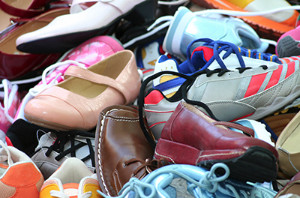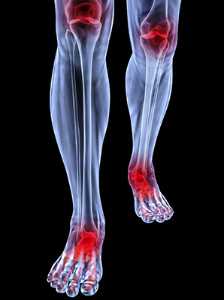 Rheumatoid arthritis is a condition that affects over 40 million Americans. Unfortunately, many people brush off their RA symptoms as less severe injuries. Many people with RA in their feet, notice the feeling of stiffness when they wake up in the morning. If you are suffering from rheumatoid arthritis, you may even start to notice joint stiffness throughout the day. Another common symptom is joint swelling due to inflammation. Those with arthritis will also notice pain in their joints that can potentially make walking difficult. Often, this pain appears when you are not putting the joints to use. If you suspect you have rheumatoid arthritis in your feet, you should make an appointment with your podiatrist to seek treatment immediately.
Rheumatoid arthritis is a condition that affects over 40 million Americans. Unfortunately, many people brush off their RA symptoms as less severe injuries. Many people with RA in their feet, notice the feeling of stiffness when they wake up in the morning. If you are suffering from rheumatoid arthritis, you may even start to notice joint stiffness throughout the day. Another common symptom is joint swelling due to inflammation. Those with arthritis will also notice pain in their joints that can potentially make walking difficult. Often, this pain appears when you are not putting the joints to use. If you suspect you have rheumatoid arthritis in your feet, you should make an appointment with your podiatrist to seek treatment immediately.
Because RA affects more than just your joints, including the joints in your feet and ankles, it is important to seek early diagnosis from your podiatrist if you feel like the pain in your feet might be caused by RA. For more information, contact one of our podiatrists of Westside Podiatry Center, LLP. Our doctors will assist you with all of your podiatric concerns.
What Is Rheumatoid Arthritis?
Rheumatoid Arthritis (RA) is an autoimmune disorder in which the body’s own immune system attacks the membranes surrounding the joints. Inflammation of the lining and eventually the destruction of the joint’s cartilage and bone occur, causing severe pain and immobility.
Rheumatoid Arthritis of the Feet
Although RA usually attacks multiple bones and joints throughout the entire body, almost 90 percent of cases result in pain in the foot or ankle area.
Symptoms
- Swelling and pain in the feet
- Stiffness in the feet
- Pain on the ball or sole of feet
- Joint shift and deformation
Diagnosis
Quick diagnosis of RA in the feet is important so that the podiatrist can treat the area effectively. Your doctor will ask you about your medical history, occupation, and lifestyle to determine the origin of the condition. Rheumatoid Factor tests help to determine if someone is affected by the disease.
If you have any questions please feel free to contact one of our offices located in Liverpool, Camillus, Skaneateles, Oswego, and Cicero, NY . We offer the newest diagnostic and treatment technologies for all your foot and ankle needs.
 Foot care
Foot care






